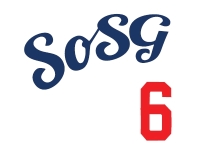Realistically, Hideo Nomo probably won't make the Hall of Fame. But, in addition to Jay Jaffe's SI.com piece on Nomo as a pioneer, there was a more tongue-in-cheek series on Deadspin last month that chronicled the impact of a number of MLB players up for HOF candidacy, and the post about our own Nomo was pretty sweet:
He went into his ritual windup, summoning pitches from a place no one else had access to. He walked back from the mound, keeping his eyes on the grass. He disappeared from the public eye between starts. They called him the Tornado, but he was quiet and still, even at the center of a storm of tchochkes and sellout crowds at Dodger Stadium and kids who were mesmerized by his windup, his forkball, and even his name. We said it a lot. Nomo, Nomo, Nomo.
Loving or not loving Nomo was never a consideration. He wasn't some hero like Mike Piazza or Ramon Martinez; he was a player you were awed by. In Los Angeles, a city that makes men into metaphors just by putting them on television, Nomo transcended his own performance immediately.
In 1995, the year the baseball strike ended, he exploited a loophole to get out of his Japanese contract, and signed in February, coming in essentially as a replacement for Dodgers legend Orel Hershiser. In his first start, he tossed five shutout innings, allowing one hit and striking out seven. The Dodgers blew a 3-0 lead, then lost the game in the 15th, but no matter; Nomo was, immediately, the symbol of a Dodger franchise that felt ascendent in both moral and baseball terms, an antidote to strike-related cynicism. As the first player who'd come to the majors from the Japanese league since Masanori Murakami decades earlier, Nomo hearkened back to Valenzuela, to Branch Rickey and Jackie Robinson, to the idea that the Dodgers were an innovative and upstanding franchise. [...]
The thing about phenomena like Nomomania or Fernandomania is that they're inherently unsustainable; even had Nomo maintained his early excellence, the hype surrounding him would have calmed. Instead of disappearing altogether, though, he pitched effectively into his mid-30s, bouncing from the Mets to the Tigers to the Red Sox, and back to the Dodgers. His last good season came in L.A. in 2003. He went 16-13 with a 3.09 ERA, even though his strikeout rate had dropped by a third.
The idea that Nomo was some sort of one-trick pitcher was clearly rooted in his foreignness, in his delivery, in the way he made established American ballplayers look like fools chasing pitches in the dirt. He was a big league pitcher who outgrew his own hype, and a harbinger of change. In Nomo's rookie season, he was the only Japanese player in the major leagues. By 2008, the year he attempted his final comeback with the Royals, he was one of 19.Nomomania wrapped you up in something that you didn't quite understand. It had nothing to do with winning or losing; it was excitement built on a foundation of excitement. In retrospect, the most fascinating thing about it was the relative absence of the man himself. You didn't find Hideo Nomo speaking at elementary schools or shilling breakfast cereals like Fernando Valenzuela did in 1981, or sitting courtside at Lakers games like Yasiel Puig in 2013. Other people talked about Nomo; the man himself didn't.
More on Nomo here.
UPDATE: Nomo got 6 votes.
illustration swiped from Deadspin



0 comments:
Post a Comment